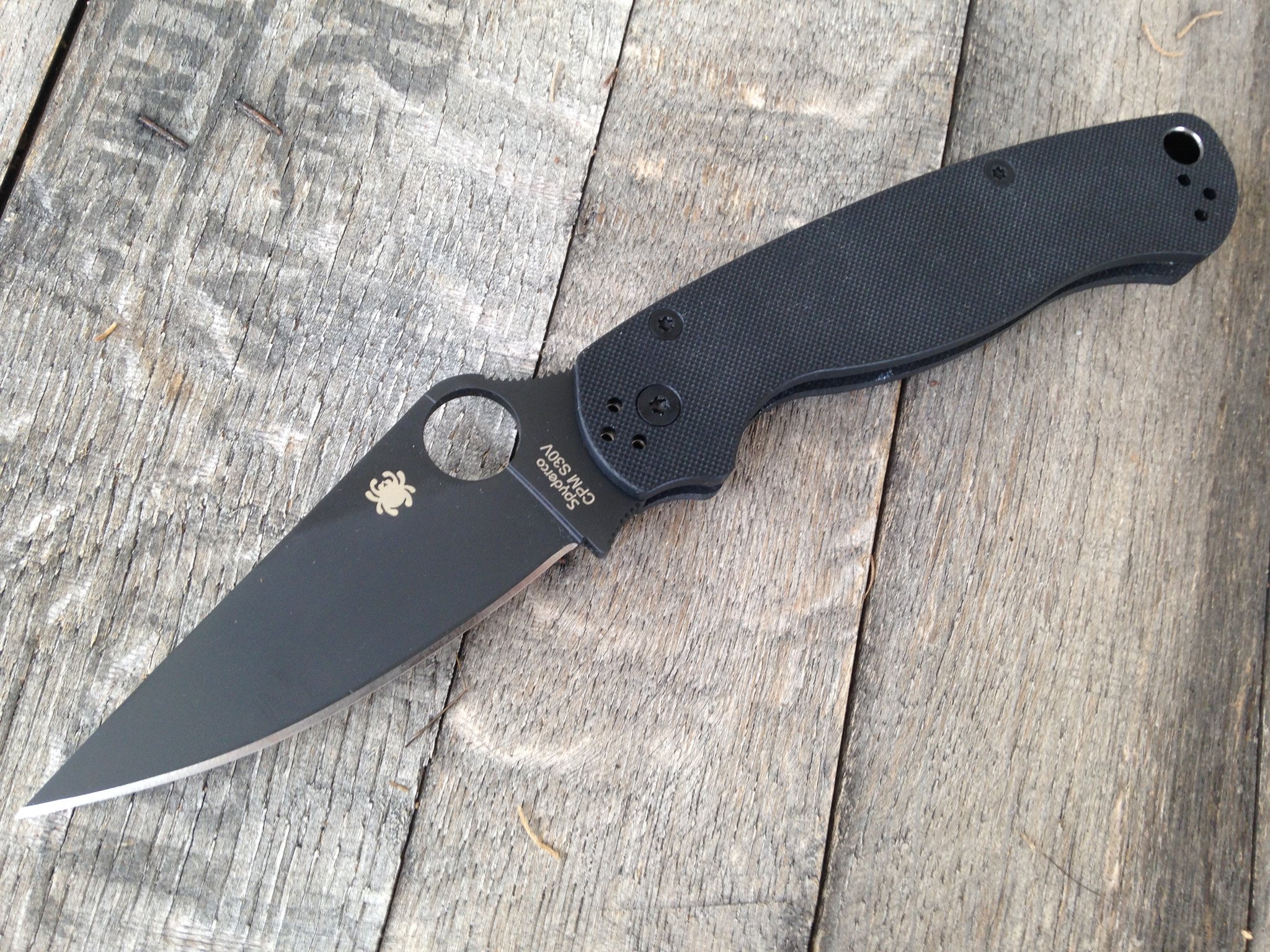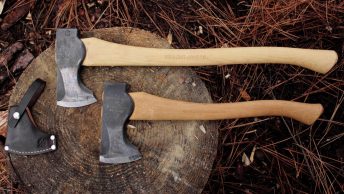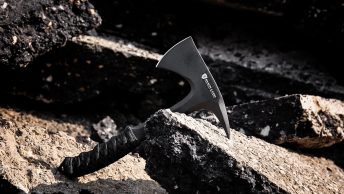‘EDC’ stands for everyday carry; all it really means is what you carry around in your pockets daily. It might include a torch, wallet, watch, first aid items, and of course, always a knife. There are plenty of choices when selecting the best EDC knife, or knives, that form part of your EDC. You can read about some of those options here and find some advice on what to look for when choosing your EDC knife.
First of all, why carry a knife every day? Well, there are always packages to open, a string to cut, boxes to break down, apples to peel, and any number of tasks that require a pocket knife. For those of us who work outdoors, we have even more reasons to need a knife. Consider that some everyday carry knives will feature more than just a knife blade, and the number of simple tasks you can tackle increases dramatically. To put it simply, an EDC knife and pocket tool mean we can make it through the day without constantly having to search for a box cutter, scissors, screwdriver, or pliers.

Benchmade Bugout 535
The Bugout 535 has a 3.25” inch blade made from great steel inside a highly graspable handle. The folding action and locking mechanism truly sets it apart.

Best EDC Knife Overall
Our nod for the best overall EDC knife goes to the Benchmade Bugout 535. The Bugout 535 has a 3.25” inch blade made from great steel, yet weighs only 1.85 oz. The highly graspable handle, folding action, and locking mechanism truly sets it apart. You will never regret having this knife with you every day.
Best Value For Money
For a knife that’s well-made, attractive, and at the perfect price point, the SOG Flash II is a fantastic option. It offers a super grippy handle, a rock-solid locking system, and a 3.5-inch blade that’s long enough for most EDC tasks. The best part, it costs about a third of what some of the higher end knives do.
Best Budget EDC Knife
The CRKT Pilar is probably your best bet if money is tight. At a quarter or even a fifth the cost of most EDC knives, the Pilar is built well with a stainless steel handle and small sheepsfoot blade. It might not be as sexy as something like the Benchmade knives, but it’ll get the job done without breaking the bank.
Easiest EDC Knife to Carry
The CRKT Squid is the kind of knife you’ll forget is your pocket. It’s only three and a half inches long when folded. That’s not really large enough for things like bushcraft but it is the perfect little knife to have with you all the time.
Most Multifunctional EDC Knife
While most EDC knives are just that, a knife, the Victorinox Swiss Army Multi-Tool is a true jack of all trades. It comes with a screwdriver, bottle opener, wire stripper, and a small knife blade. If these are tasks you regularly encounter, the Victorinox is a fantastic choice.
Best High-End EDC Knife
If only the best will do, the Benchmade 940 is a knife that will cover all your bases. It’s a solidly long knife (3.4” blade), that securely locks into place with the company’s proprietary AXIS lock. It opens easily with one hand too. The only thing it’s not easy on is your wallet.
Size Matters
It is no secret that the size of a knife, especially blade size, contributes to the overall utility of the knife. There’s a reason why the best survival knives are relatively large fixed blade knives, while pocket knives are not. So too, with EDC knives. While all EDC knives are relatively small, you’ll get to consider a range of blade sizes.
There’s no denying that your skills will largely determine whether you can utilize any EDC knife to the full limits of its design intentions. Yet, you will undoubtedly perform some daily cutting tasks easier and with less effort with a larger blade, for example. There are instances where a short, bulky, and strong blade would be preferable, and we’ve included knives with those specifications on this list as well.
Regardless of your blade length preference, you’re still going to have to carry your EDC knife. Blade size, and blade steel for that matter, is a major contributor to the knife’s overall weight, though in most cases, the handle plays a larger role. A stainless steel handle will weigh considerably more than carbon fiber or a G-10 handle, regardless of the blade length.
Our EDC Knife Selection Summary
Here’s a summary of the knives that made it into our selection of the best EDC knives. If you see something you’re curious about or recognize, feel free to jump there from here. Also, this table is sortable, so click on the headers to sort the products by weight, blade length, or blade steel.
Picking The Best EDC Knife For You
There are, of course, many types of knives that you can carry with you on your person. Some may not be legal, and some are definitely not as suitable for EDC as others. I think we can all agree that a survival knife has a very different utility and application from a pocket knife, and while they can both “cut,” that’s about where the similarities end. In our opinion, 4 types of knives are most often used and are most suitable to be considered for EDC.
Pocket Knives
If you are only going to carry one type of knife, it will generally be a pocket knife of this sort, a single knife blade with perhaps a few additional tools. This is the kind of knife that will be unobtrusive in a pocket. They will seldom really raise any eyebrows unless it is particularly large or ‘tactical’ in appearance.
Large pocket knives almost fall into a category of their own. They might be justifiable for some uses, but do consider the law, and especially restrictions on blade length, before you choose your pocket knife. Some pocket knives will attach to the inside of your pocket for ease of access, but if they are heavy, they will pull on your trousers and frustrate you.
Lock Knives
Lock knives closely represent your standard pocket knives, with the notable difference that they have blades that can be locked and refolded only by pressing a button. This means you can typically use it for more onerous cutting tasks as the risk of the blade folding back on your hand has been removed. Lock knives are probably one of the most common EDC knives nowadays, but be aware that in many countries and jurisdictions, lock knives are not classed as folding knives and may be subject to separate, typically more restrictive, regulations and laws.
Multi-Tools
Defined by their multitude of tools, many now feature pliers as a central feature, but some people will call larger Swiss Army Knives equipped with many tools multi-tools as well. Larger multi-tools tend to be carried in belt pouches rather than where their heavy and angular construction can be a nuisance in a pocket.
Fixed Blades
Large fixed blade knives are not often considered for everyday carry even where the law allows you to carry them openly as people don’t need them daily. If you work outdoors or in the backcountry, you may be able to justify carrying a large fixed blade, but generally, fixed blades like bowie knives are too big and unwieldy for everyday use.
There are smaller fix-blade knives that are very capable EDC knives, the only drawback being that you can, of course, not collapse them and slip them into your pocket or hook them onto your belt. Almost without exception, you’ll be forced to wear a sheath and your belt and carry them in that. While some people swear by their fix-blade EDC, we think you get very little additional utility from a small fix-blade over a good lock blade, and the latter is simply a lot more practical actually to carry. We think small fix-blade knives make great bushcraft knives.
The 10 Best EDC Knives
This article looks at what we think are the 10 best EDC knives available to general consumers today. Choosing one can prove to be tricky. Please view our Buyers Guide should you require more information to help you make an informed purchase.
1. Benchmade Bugout 535
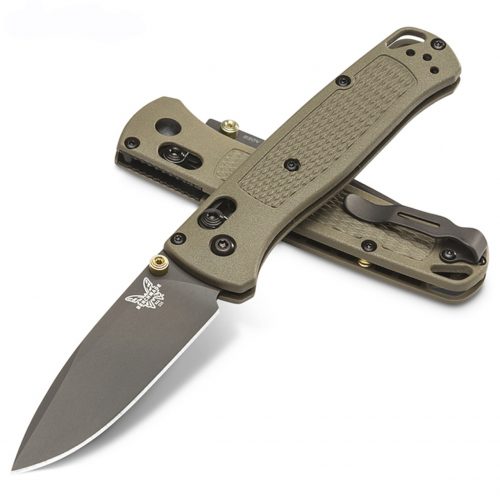

Benchmade is one of the biggest names in the EDC market; they consistently produce some of the highest-quality knives at a mid-range price point. The Bugout 535 is a perfect example of this – a 3.25” inch blade made from great steel that easily folds inside a highly graspable handle.
Let’s start by unpacking the blade; it’s a 3.25” drop point made from CPM-S30V steel. This premium stainless steel swaps in vanadium for some of the chromium that would usually be present. Vanadium increases hardness, which helps it to keep an edge longer. The flip side of that is it’s harder to sharpen to than some softer steels. Get ready to practice with your whetstone, though Benchmade has one of the best guarantees in the business and packages their knives with a free sharpening service for the product’s life.
The drop point design is well-suited for general activities and provides better durability than clip point knives, which, although sharper, are more fragile.
What really sets the Benchmade apart from the competition, though, is the folding action. The AXIS lock system works smoothly. You can open it with just one hand. Its lock utilizes a pair of omega symbol-shaped springs that move a bar through a slot until it engages with the butt end of the blade. Those springs allow it to move seamlessly from closed to open before firmly locking the blade into its unfolded position. At no point do you ever need to exert pressure on the blade.
The grip surrounding the locking mechanism is made from Benchmade Grivory material, which is essentially a molded plastic and glass composite. It feels strong, yet is incredibly lightweight (the knife weighs just under two ounces). A check pattern in the plastic provides an excellent grip in wet and dry conditions.
If there was one negative to point out with the Bugout 535, it’s the price. It’s quite a bit more expensive than most EDC knives. That’s to be expected, given the brand name and construction quality associated it with, but the high price point will be a turnoff for some buyers. However, it should be considered an investment, as you won’t need to buy a new one every year.
2. Spyderco Tenacious
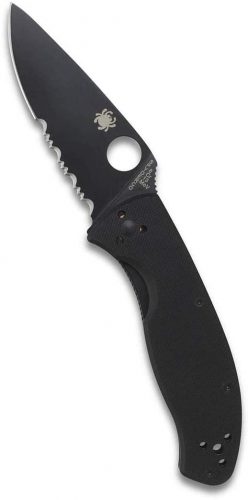

The Tenacious is an excellent mid-range EDC knife that checks a lot of boxes for quality and features. It’s not particularly small, but rather a knife that fits on your belt and reminds you that it’s there when you need it.
Let’s start with the Tenacious’s blade; it’s 3.39” long, which puts it on the lengthier end of the scale. It’s made from less expensive and imported 8Cr13MoV steel, which means it can lose its edge fairly quickly. When you buy this knife, make sure to find a quality whetstone to go along with it. You’ll get a lot of practice sharpening this knife, and that’s not a bad thing.
Spyderco added some serrations to the tail end of the blade, which can be useful if you’re cutting through things like rope or a baguette on the trail. There’s no practical way to sharpen the serrations, so once they go dull, you’ll be in the market for a new knife. A black coating on the blade protects it from rust, but it will wear off with continued use.
A downside to the Tenacious is its use of a liner lock to secure the blade in the open position. This design isn’t as strong as a frame lock and is more prone to wear. If you use the Tenacious for bigger tasks like cutting through thick materials, the liner locks will fail much quicker. To open the knife, it’s quite smooth and easy to rotate the blade via a large thumb hole in it.
One of the best things about the Spyderco is the ergonomics; the G-10 handle feels fantastic in your hand, and the textured panels give it a grip that’s second to none. The wide blade feels well-balanced, with the knife having a total length of 7 ¾”. That’s plenty of handle to provide leverage and feel secure under less than ideal conditions.
To top it off, the Tenacious has a perfectly designed pocket clip that holds strong without tearing into your clothing.
3. Victorinox Swiss Army Multi-Tool, Tinker Pocket Knife
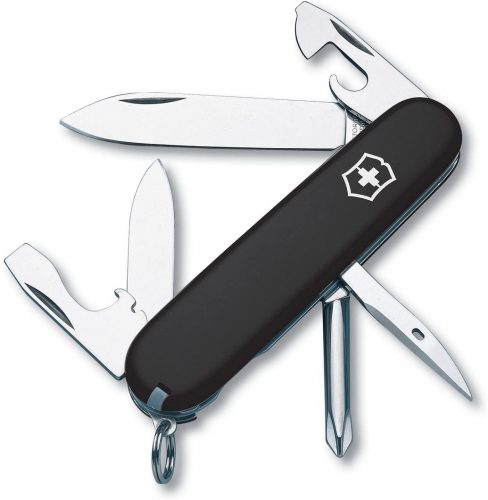

This knife should look familiar to any EDC enthusiast – it’s the classic Swiss Army knife. It’s quite different from the other EDC knives we’ve covered, as it also comes with a can opener, bottle opener, a reamer, and a Phillips head screwdriver. The Tinker is a jack-of-all-trades, but a master of none, which is something you should carefully consider before purchasing this knife.
The Victorinox’s blade is a mere 2.25 inches long, the shortest of any EDC knife on our list. It utilizes a spearpoint, which is useful for stabbing but less helpful for slicing tasks. That’s not too big of an issue as the short blade and short handle doesn’t give you much leverage. Its blade is constructed from a fairly soft stainless steel that dulls quickly, and the way it folds out from the handle makes it hard to sharpen.
Like most Swiss Army tools, the Victorinox Tinker does not have a robust locking mechanism. The additional tools necessitate a slip-joint lock, which requires two handles to safely open and close. To open, you have to put some pressure on the blade/tool shaft and push it away from the knife until it can overcome the spring tension holding it in. This causes it to “snap” open, which can be dangerous when only using one hand.
So while the Victorinox has a lot of extra functionality, it’s not something you can quickly whip out and start cutting with, at least not safely. The slip joint doesn’t really lock into place either, meaning the blade can easily slip when the knife is used for a heavy-duty task.
The handle is made from ABS plastic, which is not as durable as some of the composite EDC knives handles but is easy enough to carry and is unlikely to get damaged before the locking mechanism wears out. It also keeps the Victorinox’s weight low, with the whole knife weighing just 2.2 ounces.
Many of the above points may have sounded like harsh criticism of the Tinker: lower-quality materials, an unsafe locking mechanism, and a blade style that doesn’t have many uses, but this is to point out that the Victorinox is for a niche market. If you’re someone that regularly tightens screws and opens cans, you might be better off with a dedicated tool for the job. However, if you find yourself encountering a wide variety of problems that could be solved by a Swiss Army knife or subscribe to the motto “Always be Prepared,” this knife might be exactly what you’re looking for.
Additionally, the Tinker isn’t very expensive, so if it does encounter some durability issues, it’s not hard to replace it every few years. Just watch out for any signs of wear, because you don’t want it to break when you’re far from home and a replacement knife.
4. SOG Flash II
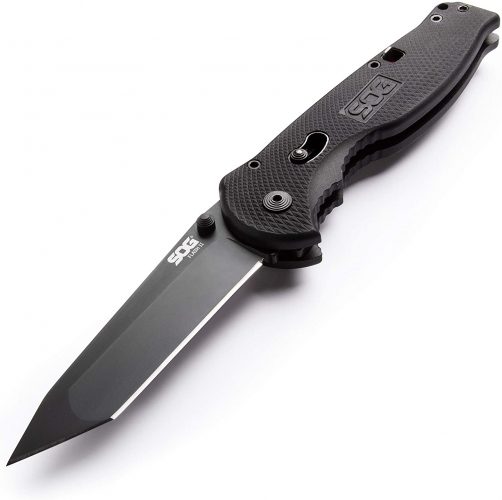

This is actually our favorite EDC knife as it checks all the boxes for features and quality while not costing all that much. The 3.5 inch tanto blade is long enough for almost any EDC task – cutting boxes, slicing through rope, making a sandwich at a picnic, it does it all. It’s constructed from Aus-8 steel, a Japanese variety of stainless that is tougher than the usual knife steel. You shouldn’t need to sharpen the Flash II as much as some of the cheaper knives on this list.
The Tanto blade has a strong point for stabbing through thick materials like an elk hide. The emphasis on the point does take away from the main cutting surface, though, as the blade angles sharply near the tip. If you do a lot of slicing with your EDC knife, this will do the job, but not as well as other blade styles like a drop tip.
The Flash II from SOG is the only assisted opening knife on this list for a reason. When it’s done well, it’s usually very inexpensive. When it’s done cheaply, it’s usually unsafe or prone to breakage. The SOG is neither of those things; it opens quickly and easily via a small button on the side of the handle. To prevent it from deploying unintentionally, there’s a small tab near the back of the knife to lock the blade inside the handle.
One of the biggest complaints with the Flash II is that it doesn’t have a liner to hold the blade firmly in place once it’s deployed. Liners are something you see on some of the higher-end models, and they take some of the “play” out of the blade. The minute movements in the blade while it’s locked in place are one of the few things that make this knife feel cheap. At the same time, it costs a third of what similar Benchmade knives would, so you have to expect minor issues like blade play.
The base model of the Flash II comes with a glass-reinforced composite handle with a lot of texture. This makes it one of the best EDC knives for wet conditions, as many of the other knives on this list have smooth handles that can lose their grip at the first sign of moisture. While not as strong as aluminum, the composite handle won’t break if you drop it and is probably stronger than the locking mechanism, so don’t worry about the handle snapping during more demanding tasks.
5. CRKT Pilar
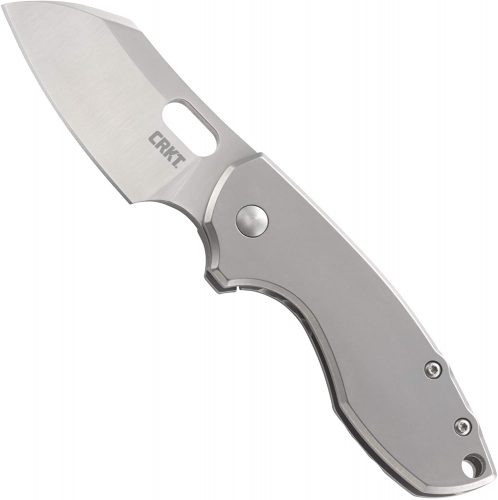

The CRKT Pilar may not look like much, but big things can come in small packages. This package is a mere 5.9 inches in length with a 2.5-inch blade. You won’t be chopping wood with this short of a knife, but it’s great for more urbane activities or lightweight camp tasks like slicing vegetables or whittling on a marshmallow skewer.
The Pilar uses a sheepsfoot style blade, which is particularly adept at slicing but lacks the sharp point seen on clip and drop point knives. That makes it considerably safer – a big advantage for a knife that you carry everywhere and might pull out of your pocket several times per day. It uses a cheaper form of stainless steel, 8Cr13MoV, but that softer steel is advantageous in that it’s quite a bit easier to grind on and sharpen.
The softer metal tends to bend instead of break (or chip), so the Pilar may need only a stropping to get it back into shape. Using lower-tier stainless also helps keep the price down; the Pilar is one of the best value for money EDC knives.
To open the Pilar, you have the option of engaging a thumb hole or rotating a flipper on the spine of the knife. Both are incredibly smooth, and you can easily open the knife with one hand. Once opened, it secures in place with a rock-solid frame lock.
The handle on the Pilar is stainless steel, which does wonders for durability but isn’t so great if your hands are wet or slippery. There’s not much of a textured surface to hold onto, so this isn’t the best option if you’ll be using it for activities like hunting or watersports, where grip is paramount. There are three finger troughs on the backside of the knife, but these are more useful for guiding your hand placement rather than holding the knife firmly. The stainless handle undoubtedly adds to the weight too. The Pilar comes in at 4.2 ounces, which feels hefty for a 2.5-inch blade.
If you’re a fan of sleek lines and smooth surfaces (think Apple products), the Pilar will definitely be to your liking. For others, the metallic faces of the handle and lack of embellishments will feel too utilitarian and soulless. Don’t buy this knife if you’re looking for a showpiece; it’s a budget-friendly, no-nonsense kind of knife.
6. Spyderco Para Military 2
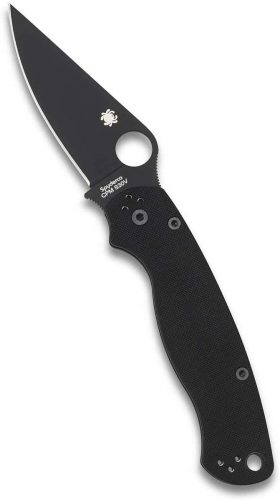

The Para Military 2 from Spyderco is one of the better options if you’re looking for a full-sized EDC knife but don’t want to pay out the nose for it. This version comes with a nearly 3.5-inch blade (total length of 8.25 inches) with a drop point. The blade type is versatile, working equally well for stabbing or slicing through tough material.
Its blade is constructed from CPM S30V steel, the same ultra-hard steel used in the Benchmade Bugout. This type of stainless does not dull easily, keeping an edge for years if you take proper care of it. A large thumbhole near the spine makes quick work of opening the knife and allows for easy, one-handed operation.
The Para Military 2 comes with a compression locking system, something of a reverse liner lock. While liner locks engage at the base of the blade butt, in the space the blade pivots through, the compression lock engages the blade closer to the spine at the butt end. This is more effective as the liner lock wedges itself between a notch in the blade butt and the stop pin in the handle. No matter how hard you push on this blade, it will not swing into the handle.
The compression lock not only improves the Para Military’s safety but also reduces blade play. This knife has less movement than perhaps any other model besides the Benchmades when the blade is in the open position. For a knife that’s priced a few levels below the Benchmade, that’s a big deal.
The handle of the Para Military is another high point; built from durable G-10 composite, it is both rock-hard and extra grippy. Spyderco could have added some texturing to the handle for an even better hold, but it really wasn’t necessary as the composite has a sort of innate stickiness to it.
There’s really nothing bad to say about the Para Military except that it’s expensive. It’s in the same price class as the Benchmade knives, which puts it out of reach of budget consumers and those just getting into the EDC market. However, you won’t need to replace this knife in a year or two, something that you can’t say of some of Spyderco’s competitors. It’s an investment and one worth making if you get a lot of use out of your EDC knife.
7. Zero Tolerance 0450CF
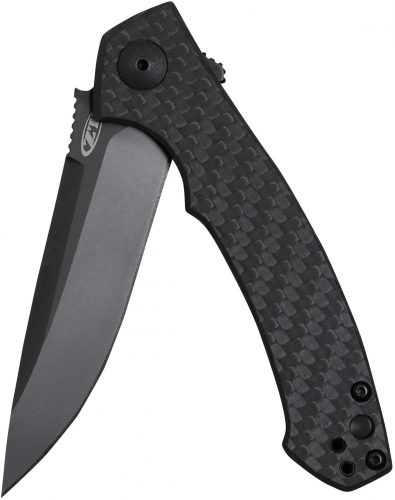

If there were ever an overbuilt knife, it would be the Zero Tolerance 0450CF. Just one look and you’ll know there is something special about it. That something special is a carbon fiber and titanium handle topped off with a blade made from CPM S35VN – one of the highest quality stainless steels out there.
Let’s start with the basics; it’s a larger knife, measuring 7.375 inches when unfolded and just over 3.25 when folded up. That’s a bit bigger than your average EDC knife, but because of the high-quality materials used in it, the Zero Tolerance weighs only 2.45 ounces. That’s actually a little jarring, and if you’re not convinced about the materials, it actually feels cheap. Make a few cuts with it, and you’ll be relieved of that suspicion.
The blade is a classic drop point, with a long belly and a very sharp point. It’s not a specialized form and does every task equally well. It’s made from CPM S35VN, which is considered about 20% tougher than the CPM S30V that Benchmade uses in their knives (which is already a cut above cheaper stainless steel). It’s hard and resists rolling over when slicing through dense materials, but it’s not so hard that you can sharpen it with a regular whetstone. It also sports a matte black coating to prevent rust, but it will wear off over time.
Where the 0450CF really shines is in the opening mechanism. This is a flipper knife, which means there’s a tab on the blade’s spine that you can engage with your finger to rotate the blade out of the handle once the locking mechanism is released. The motion is incredibly smooth, thanks to the ball bearing system at its pivot point. It deploys quickly, but unlike mechanical assist knives, you don’t need to worry about accidental opening as there are no springs to contend with.
The 0450CF’s handle is made from carbon fiber with a titanium frame underlying it. Not only does this look amazing, it really cuts down on the weight. It’s why this 7.375-inch knife weighs only a little more than a tiny Swiss Army knife. The smooth sides give a great grip, especially since carbon fiber already has a very smooth feeling. So this may not be the best option if you’re working in a wet environment.
The other drawback is the price; this is the most expensive EDC knife on this list. Its price point hovers around $200, four to six times as much as the bargain knives we reviewed. If you purchase the 0450CF, you need to be sure it’s the kind of knife you need. If you don’t, you’re sure to have a case of buyer’s remorse.
8. Kershaw Shuffle II


The Kershaw Shuffle has been one of the best-selling knives over the past few years, especially among consumers looking for a shorter blade. The Shuffle II follows in its predecessors’ footsteps while adding some fantastic new features.
The Kershaw has one of the smaller blades amongst EDC knives, just 2.5 inches, and the whole knife is 6.25 inches when opened. That’s not enough for slicing, and the tanto blade decreases the usable cutting surface, but it’s definitely enough for a box cutter. It’s also plenty of blade for smaller tasks like skinning fruit and great for detail work like field dressing a deer. The Tanto blade dual cutting surfaces are especially useful for this. It’s made from cheaper 8Cr13MoV steel that will need regular sharpening to keep an edge; it’s a trade-off to keep the price down.
The Shuffle also makes an attempt as a multitool. Kershaw states that it has a bottle opener and a flathead screwdriver, but at least one of those claims is debatable. The bottle opener is actually just the lanyard hole at the butt end of the knife, and it works relatively well. However, the screwdriver is just a small metal sticking out of the lanyard hole. You have to rotate the knife body around it to turn a screw. It’s clunky and not very useful. Presumably this was just added so people would stop using their knife tip to twist screws.
If you’re looking for a knife that grips well when wet, this is probably one of the better ones. The handle is made from glass-filled nylon plastic – a composite material that is both strong and a little bit sticky in your palm. Kershaw added some thick texturing to the grip that curls around your fingers for an even firmer hold. Combine that with the short blade length, and you’ve got one of the most maneuverable EDC knives that’s perfect for detailed tasks. It also has a large loop on the back end, which you can use for attaching a lanyard or carabiner.
As far as budget EDC knives go, the Kershaw has a lot to offer: extra tools, a super grippy handle, and a rock-solid blade. Its compact length makes it useless for heavier tasks, but it’s a solid EDC within the confines of its design.
9. CRKT Squid


At first glance, the CRKT Squid doesn’t look like much; folded up, it’s only three and a half inches long. Unfold the blade, and you only get another two and a quarter inches. It’s certainly not designed for chopping firewood…That’s precisely the point – EDC knives are designed for carrying every day. They’re meant for the small and unexpected tasks, not the kind you’d remember to pack a six-inch fixed blade for. The Squid’s diminutive size makes it perfect for slipping in your pocket and forgetting about until the need arises.
The two-and-a-quarter-inch blade on the Squid is made from 8Cr13MoV – very inexpensive stainless steel. It’ll get the job done, but don’t expect it to hold an edge for very long; you should sharpen it regularly. It goes without saying that the Squid won’t hold up to any heavy-duty tasks. The blade is only 0.11” thick and could bend or break if too much pressure is applied.
The Squid’s locking mechanism is nothing to brag about either, a frame lock that takes some pressure to open and loses its strength over time. It’s not easy to unfold this knife with one hand, but you can do it. It is easier to clean than some more complicated models, so this could be a good choice for anyone who tends to soil their knife with dirt, blood, or any other debris.
Its sleek aluminum frame gives this inexpensive knife a very attractive aesthetic, but doesn’t do much for grip. If it’s wet, there’s really nothing to help you hold on. However, some indentations near the pocket clip make it easier to take on and off. The aluminum sides, combined with a simple design and short stature make the knife feel nearly indestructible too.
While the CRKT Squid has plenty of flaws, you have to keep in mind what it is: a very inexpensive knife that costs a quarter of what many of its competitors do. It’s a knife you’ll carry with you wherever you go, but won’t cause you to get upset if you forget it at a campsite. For many users, that’ll be more than enough reason to buy it.
10. Benchmade 940
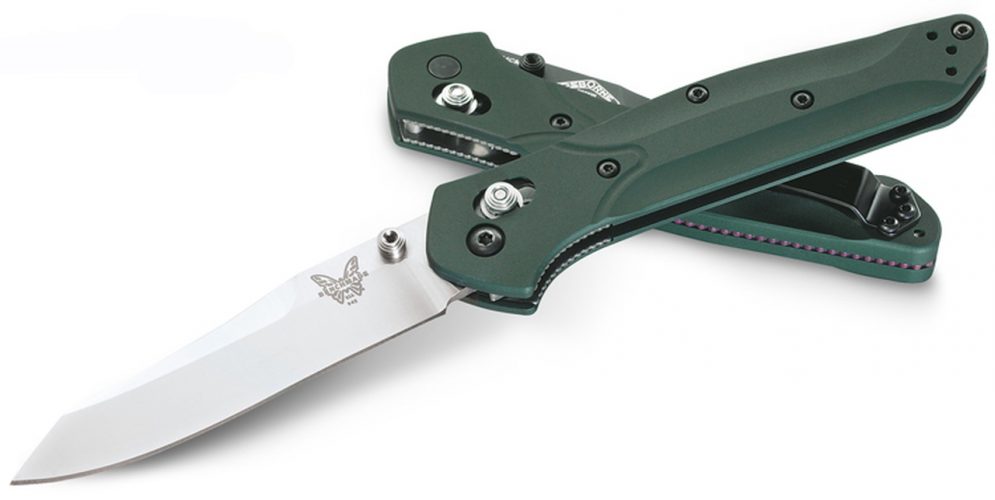

Benchmade’s 940 is essentially an improvement on the Bugout with a few extra options. The base knife is a reverse tanto blade on an aluminum frame with no blade coating, while the top-end version has a carbon fiber handle and a serrated blade. For our purposes, we’ll be talking about the base model.
The 940 has a price point around 50% higher than Benchmade’s Bugout, which can be hard to justify. The aluminum-handled version uses the same blade steel as the Bugout, though the carbon fiber model has the higher quality CPM-S90V steel (and a price that’s closer to double that of the Bugout). The blade isn’t much longer, less than a quarter of an inch different, and the locking mechanism is the same. As such, the 940 is best suited for buyers that need to have the very best – which it is, as far as EDC knives go.
Benchmade went with a reverse tanto blade on the 940, one of the best designs for everyday carry. The reverse tanto has a longer cutting edge as the tip angles sharply up towards the spine rather than from the tip to the belly as a tanto blade does. It’s handy for slicing tasks where you need a long surface with even pressure exerted along the length of the blade.
One of the biggest reasons knife buyers choose a Benchmade is for its proprietary AXIS locking mechanism. It’s one of the safest folding mechanisms as you don’t put any pressure on the blade to engage or disengage the lock. You have to move a spring-loaded pin in the handle, but this pin is far enough away from the blade and can be operated by right or left-handed users. Once it’s engaged, the lock feels much more secure than a liner or frame lock, giving it more of a fixed blade knife feel.
The base model of the 940 comes with an aluminum handle, which usually isn’t great for grip. However, Benchmade has given it some texture to reduce slippage and enhance blade control. It certainly doesn’t add to the weight, as the 7.9-inch knife comes in at just under 3 ounces. A metal handle gives the 940 better durability compared to many of its competitors too.
EDC Knife Buyers Guide
Two Knives – Proper Preparation or Overkill?
With all the options that exist for your EDC knife, you may be tempted to want to carry more than one. In fact, you can easily find some Youtubers who will walk you through all kinds of EDC knife combinations suited for everything from cleaning your fingernails to fighting off the Zombie Apocolypse!
We think that under most circumstances carrying two EDC knives is overkill. Having two single-bladed knives of just slightly different sizes seems too much, unjustifiable in terms of weight, pocket space, and utility. Some rare combinations might make sense, perhaps a combination of a multitool and a simple folding knife, but in general, carrying more than one knife on an everyday basis will be too much unless you have a particular need for it.
EDC Knives For Emergencies
Some people advocate EDC’ing kit specifically in preparation for emergencies and survival scenarios and while this isn’t a bad idea, remember that what you really want in an emergency survival scenario is your survival knife and a well-stocked bug-out bag rather than relying on the contents of your pockets. Are you really going to try and pack loads of survival gear into your pockets daily, or would you be better off upskilling and improving your survival skills rather than contriving ways to carry more and more tools?
If your reason for EDC’ing a knife is so you are prepared for emergencies, consider very robust knives as you will presumably want to press them to backwood tasks that you would prefer to have your survival knife for. Small fixed blades or very robust lock knives are what you want to fill this role.
Take Precautions Not To Lose Your Knife
EDC knives, by virtue of their purpose, will be moved and carried around every day. As with any high-use item, the risk of losing them is actually substantially higher than most other knives in your collection. There are a few common-sense steps you can take to ensure you don’t lose your knife.
Consider pocket clips, belt pouches, and lanyards to keep your knife fastened securely to your person. If you do lose it, at best, it’s a minor inconvenience but might be a loss of an expensive tool, or at worst, you may lose your knife and find yourself in an emergency where you really need it. Make sure you have a sensible carry solution to minimize your risk of losing your knife.
That being said, most of the knives we recommend here won’t break the bank, but we believe every knife is an investment worth protecting.
Knife Carry Laws and Regulations
Before choosing a knife for EDC, consider your local laws regarding carrying a knife in a public place. When we talk about EDC, we need to distinguish between what you can legally possess and what you can have on you in a public place. Suppose we are to understand that we need to be sure about what different kinds of knives are. Common sense tells us the difference between fixed and folding blade knives, but specific types of knives are often the subject of legislation due to their function as a weapon.
It’s worth knowing a few of these knife types that often feature in knife law. Generally, they are mentioned in law to prohibit them, but some particular knives and knife mechanisms would be useful to understand.
Not only are the following knife designs more often regulated by law, but we also don’t think they’re useful EDC options for anyone seriously considering a single knife to help them with everyday tasks or emergencies.
Balisong or Butterfly Knife
These are knives concealed within a handle that splits open down the middle to reveal the blade inside. They work in the same way that most multi-tools work except with a blade instead of pliers, and they are often spun around, and people will do tricks with them. There is a perception of them as weapons, and historically, many people have been hurt by them, even though many wounds are self-inflicted.
Stiletto Knife
Stiletto knives are thin pointed knives specifically designed for stabbing. The concept is ancient and was used in medieval times in Rondell or ballock daggers for stabbing through the chinks in armor. Modern knives that share characteristics with stilettos are the classic Fairburn Sykes commando dagger and the U.S Marine Raider Stiletto. The blade shape was often adapted into automatic ‘flick’ knives when they became popular.
Automatic Knives
These are folding knives, although they do not all fold at a hinge but rather, in many models, the blade collapses back into the handle like a telescope. The blade is deployed by pressing a button or activator, which under the power of a spring releases the blade, which flicks out and locks into place.
Gravity Knives
Often confused with automatic knives as they are also sometimes called ‘flick’ knives, these deploy with a flick of the wrist, which allows the blade to deploy and lock into place.
Conclusion
So regardless of what you do or where you go – having an EDC knife can be nothing but beneficial. Sure there are downfalls, as mentioned above, but we highly recommend that you explore the options above on our list. You never know when you might need one.

Benchmade Bugout 535
The Bugout 535 has a 3.25” inch blade made from great steel inside a highly graspable handle. The folding action and locking mechanism truly sets it apart.

Ryan is an outdoor enthusiast and gear expert originally from Montana who spent four years living in Boston, after stints in India, Rwanda, Senegal, and elsewhere. He and his wife are on a new journey to travel the world and blog about their adventures at Passions and Places.

